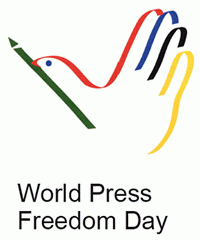AUCKLAND (Pacific Media Watch): Brutal repression of journalists and civil rights in Indonesian-ruled West Papua, censorship and self-censorship in Fiji and abuses of a free press in Papua New Guinea and Vanuatu have been highlighted in a Pacific media freedom report being published tomorrow.
The 41-page report by the Pacific Media Centre’s freedom project Pacific Media Watch is a harrowing indictment of the “fragile” state of the media in the region. Marking the UNESCO World Press Freedom Day (WPFD) - observed globally on May 3 each year - the report is also accompanied by an eight minute video about the media made by a School of Communication Studies crew at the Auckland University of Technology.
Marking the UNESCO World Press Freedom Day (WPFD) - observed globally on May 3 each year - the report is also accompanied by an eight minute video about the media made by a School of Communication Studies crew at the Auckland University of Technology.
“The state of Pacific media freedom remains fragile with setbacks across the region in spite of the brief glimmer of hope in Fiji with the lifting of the Public Emergency Regulations (PER) at the start of this year,” said Pacific Media Centre director Professor David Robie.
“While official censorship has been lifted, the tough Fiji Media Industry Development Decree imposed by the military-backed regime is still in force and is a major chilling factor for the local – and foreign – news media.
“Self-censorship is rife and suspicion plagues rival media groups eyeing a favoured place in an authoritarian mediascape.
“It is not an encouraging environment for freedom of expression as the country looks to the promised and hoped for elections in 2014.”
Media freedom video
The media freedom video, reported by Pasifika student Jordan Puati and directed by AUT television journalism lecturer Danni Mulrennan, examines media freedom issues in New Zealand as well as the Pacific.
It also highlights freedom issues faced by Māori, Pasifika and ethnic journalists in comparison to the mainstream media culture.
The video and media freedom report will be launched at a WPFD seminar hosted by the Pacific Media Centre and chaired by Fijian Dr Steven Ratuva of Auckland University’s Centre for Pacific Studies at AUT tomorrow night.
Dr Robie said the media freedom report had been republished in book form from an article published in Pacific Journalism Review late last year.
He said the worrying trend set last year had continued into this year and he cited the following issues:
• Fiji: The lifting of the Public Emergency Regulations (PER) has ended formal censorship the draconian Fiji Media Industry Development Decree 2010 is still in place: “Many journalists and civil society advocates are still fearful of speaking out due to the harsh legal penalties that they face under the law and this will damage the democratisation process,” Dr Robie said.
• Papua New Guinea: A rise in assaults and intimidation of journalists reporting on the ongoing political crisis with “two governments” since late last year, two violent incidents involving armed police. “The continued political uncertainty and climate of impunity has raised the stakes for journalists,” Dr Robie said.
• West Papua: “In the past year, there have been two killings of journalists, five abductions or attempted abductions, 18 assaults (including repeated cases against some journalists), censorship by both the civil and military authorities and two police arrests (but no charges),” said the media freedom report.
Dangerous places
Dr Robie said: “Clearly the two provinces of West Papua are the most dangerous places for the media in the Pacific region.
“While politically, the territory is regarded globally as part of Indonesia, the Papuans are Melanesian and the Pacific Islands Forum and Pacific media advocacy groups should be giving their Melanesian brothers priority support.
“This is the major media freedom hot spot at the moment. But it is mostly dropping below the radar for Australia, New Zealand and independent Pacific nations.”
The WPFD seminar “Media Freedom in the Pacific: The rhetoric and the reality” will be held at the Pacific Media Centre (WT1004) in the AUT Tower building, 2 Rutland St, Auckland, 7-8.30pm, tomorrow night.
The media freedom video and another one from Fiji Television will be screened, followed by a lively seminar featuring independent Fiji blogger Professor Crosbie Walsh; Pacific Islands Media Association (PIMA) chair Iulia Leilua; Papua New Guinea journalist Henry Yamo and Pakistani journalist and media educator Rukhsana Aslam.
More information
PMC media freedom video
Pacific Media Watch media freedom report
Featured on Taimi Media Network (Tonga)
This work is licensed under a Creative Commons Attribution-NonCommercial 3.0 New Zealand Licence.
WORLD PRESS FREEDOM DAY 2012 A Pacific media freedom video featuring Iulia Leilua (Pacific Media Islands Association - PIMA), John Pulu (Tagata Pasifika) and Alex Perrottet (Pacific Media Watch). Reporter: Jordan Puati Other reports include: NZ must be vigilant over media freedom, says PIMA chair Pacific press freedom fragile, says PMC academic A discussion our news media need to have Press freedom a delicate flower in the Pacific Free speech no fait accompli, says PMW editor Assaults, repression, self-censorship plague Pacific media, says new PMW report




